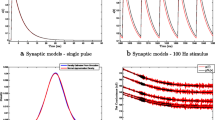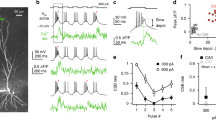Abstract
Neurons often cause bursting discharges in synchrony in the hippocampal CA3 region, which has rich excitatory and inhibitory recurrent connections. It has been supposed that the recurrent inhibition is important to synchronize the neuronal activity. Many types of interneurons exist in the CA3 region. In particular, oriens- lacunosum moleculare (O-LM) cells have a distinctive feature; the cells are resonant and have a resonance frequency in the theta range. In this paper, we investigated how the O-LM cells effectively promoted synchronization of neuronal activity using a hippocampal CA3 network model. As a result, although synchronization of spike bursts of pyramidal cells was improved a little due to the resonant activity of the O-LM cell in comparison with the network with fast- spiking inhibitory neuron, the synchronization was still poor. However, when the basket cells inhibited the O-LM cell unilaterally, synchronization of spike bursts of pyramidal cells was improved dramatically.
Access this chapter
Tax calculation will be finalised at checkout
Purchases are for personal use only
Preview
Unable to display preview. Download preview PDF.
Similar content being viewed by others
References
Cobb, S.R., Buhl, E.H., Halasy, K., et al.: Synchronization of neuronal activity in hippocampus by individual GABAergic interneurons. Nature 378, 75–78 (1995)
Tateno, K., Hayashi, H., Ishizuka, S.: Complexity of spatiotemporal activity of a neural network model which depends on the degree of synchronization. Neural Networks 11, 985–1003 (1998)
Kunec, S., Hasselmo, M.E., Kopell, N.: Encoding and Retrieval in the CA3 Region of the Hippocampus: A Model of Theta-Phase Separation. J. Neurophysiol. 94, 70–82 (2005)
Author information
Authors and Affiliations
Editor information
Editors and Affiliations
Rights and permissions
Copyright information
© 2010 Springer-Verlag Berlin Heidelberg
About this chapter
Cite this chapter
Matsubara, S., Hayashi, H., Nakada, K. (2010). Spatiotemporal Synchronization of Neuronal Activity in a Hippocampal CA3 Network Model Including the O-LM Cell. In: Hanazawa, A., Miki, T., Horio, K. (eds) Brain-Inspired Information Technology. Studies in Computational Intelligence, vol 266. Springer, Berlin, Heidelberg. https://doi.org/10.1007/978-3-642-04025-2_20
Download citation
DOI: https://doi.org/10.1007/978-3-642-04025-2_20
Publisher Name: Springer, Berlin, Heidelberg
Print ISBN: 978-3-642-04024-5
Online ISBN: 978-3-642-04025-2
eBook Packages: EngineeringEngineering (R0)




